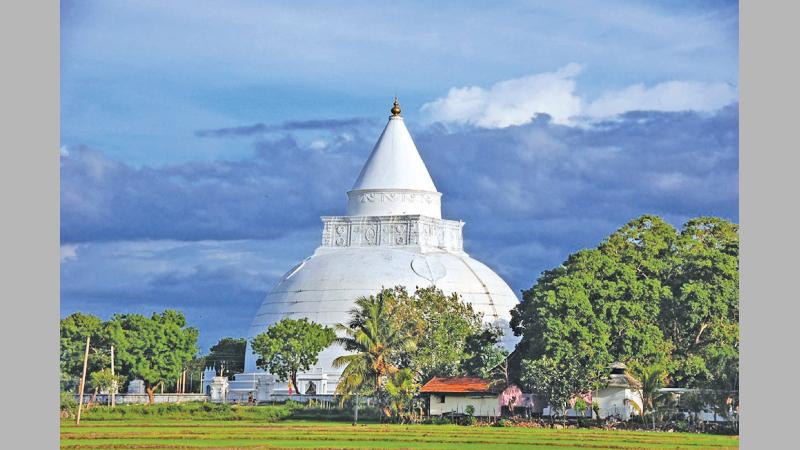
The Tissamaharama Raja Maha Vihara is an ancient Buddhist temple in Tiissamaharama, in the Southern Province of Sri Lanka. It was one of the four major Buddhist monasteries established in Sri Lanka, after the arrival of Arahath Mahinda Thera to the country.
It is said that the site of the Tissamaharama Raja Maha Vihara was consecrated by the Buddha, who spent some time there in meditation with 500 Arahaths (those who have reached enlightenment), during his third visit to the island.
The Tissamaharama monastery
The Tissamaharama monastery had been recognised as an eminent Buddhist educational centre of Southern Sri Lanka from the 3rd century B.C. to the 11th century A.D. The Tissamaharama Dagoba which is on the premises of the monastery is one of the largest stupas in Sri Lanka. The present chief incumbent of the Tissamaharama Raja Maha Vihara is Ven. Devalegama Dhammasena Nayaka Thera.
Arahath Mahinda
During the reign of Emperor Asoka of India (304–232 BCE), many prominent Bhikkhus were sent as missionaries to neighbouring kingdoms to spread the Buddhist philosophy.
Arahath Mahinda Thera, the son of Emperor Asoka arrived in Sri Lanka during the reign of King Devanampiyatissa of Anuradhapura in the 3rd century BC. After the establishment of the Buddha Sasana in Sri Lanka, major Buddhist monasteries such as the Anuradhapura Maha Vihara and Mihintale Raja Maha Vihara were established in the North Central region of the country while the Tissamaharama Raja Maha Vihara and Sithulpawwa Vihara were set up in the Southern region.
According to the chronicle, the Mahawamsa, this temple was built in the 2nd century BC as Silapassa Pirivena, by King Kavantissa (186-161 B.C.) of Ruhuna (Southern Sri Lanka). In the reign of King Ilanga (38-44 A.D.) the temple had been expanded and renovated. But according to some historians, the temple was initially built by King Mahanaga in the 3rd century BC and later it was expanded as a major temple by king Kavantissa in the 2nd century BC.
The Tissmaharama Vihara was the largest Buddhist monastery in historic Southern Sri Lanka. Some of the notable resident Buddhist monks of this great monastery include Arahath Mahasiva Thera, Arahath Dhammadinna Thera and Arahath Pindapathika Tissa Thera.
King Kavantissa who founded the Tissmaharama Vihara also modified the Tissa wewa (tank) to cater for the water requirements of the Tissamaharama monastery, as well as for irrigation purposes of the surrounding area.
The many ancient kings of Sri Lanka also offered land to the Tissamaharama monastery for the welfare of the Bhikkhus who lived there.
Stone inscriptions
According to ancient stone inscriptions many land donations to the Tissamaharama Vihara were made during the reigns of kings Jetta Tissa, Wasabha and Mihindu. From the 3rd century to the 5th century the monastery owned more than 18, 000 acres of land.
These land donations were made by the kings for the maintenance work of the monastery and the stupa as well as for the needs of the resident Bhikkhus.
The Tissamaharama stupa is the largest stupa in the Southern region of the country with a height of 156 feet and 550 feet in circumference.
According to the chronicles, King Kawantissa had sought blessings and instructions from Arahath Gothama Thera, who was a spiritual adviser to the king, when constructing the Tissamaharama stupa. The stupa was built to commemorate the Buddha’s visit to the area, at the same place where the Buddha spent time in meditation with 500 Arahath Bhikkhus.
The stupa has a ‘Bubble Shape’ and was built by using bricks on a square platform made of granite stones. King Kavantissa received the instructions of Bhikkhus throughout the construction of the stupa.
Sacred relics
According to the Mahawamsa, the frontal bone relic (Lalata Dhathu) is enshrined in the Tissamaharama stupa as the main relic.
However, some believe that the frontal bone relic of the Buddha was temporally enshrined in this stupa but later it was enshrined in the Seruvila Mangala Maha Chethiya. A recent discovery of a pillar inscription in Kirinda, reveals that the left tooth relic of the Buddha was also enshrined in this stupa.
The more recent restoration work of this stupa begun in 1858 due to the efforts of Wepathaira Sumana Thera, who rediscovered the Tissmaharama Vihara after making a pilgrimage to the area. He built a hut in the vicinity of the stupa and started living there to supervise the restoration work by himself.
It took 16 years to complete the renovation work of the Garbhaya, a semi-spherical part of the stupa which is 86 feet in height. But Wepathaira Sumana Thera could not complete the restoration of the Tissmaharama stupa in his lifetime.
After the death of Wepathaira Sumana Thera, Walpita Medhankara Thera, took over the renovation work.
By 1878, Walpita Medhankara Thera managed to complete the restoration of the Hatharaskotwa of the stupa and enshrined relics in it. The Tissa aharamaa Vihara holds a special place in buddhist culture. It’s our duty to protect it.
Yashodhara Paranagama
Grade 9 H
Musaeus College
Colombo 7
